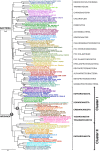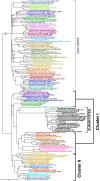The two-domain tree of life is linked to a new root for the Archaea
- PMID: 25964353
- PMCID: PMC4450401
- DOI: 10.1073/pnas.1420858112
The two-domain tree of life is linked to a new root for the Archaea
Abstract
One of the most fundamental questions in evolutionary biology is the origin of the lineage leading to eukaryotes. Recent phylogenomic analyses have indicated an emergence of eukaryotes from within the radiation of modern Archaea and specifically from a group comprising Thaumarchaeota/"Aigarchaeota" (candidate phylum)/Crenarchaeota/Korarchaeota (TACK). Despite their major implications, these studies were all based on the reconstruction of universal trees and left the exact placement of eukaryotes with respect to the TACK lineage unclear. Here we have applied an original two-step approach that involves the separate analysis of markers shared between Archaea and eukaryotes and between Archaea and Bacteria. This strategy allowed us to use a larger number of markers and greater taxonomic coverage, obtain high-quality alignments, and alleviate tree reconstruction artifacts potentially introduced when analyzing the three domains simultaneously. Our results robustly indicate a sister relationship of eukaryotes with the TACK superphylum that is strongly associated with a distinct root of the Archaea that lies within the Euryarchaeota, challenging the traditional topology of the archaeal tree. Therefore, if we are to embrace an archaeal origin for eukaryotes, our view of the evolution of the third domain of life will have to be profoundly reconsidered, as will many areas of investigation aimed at inferring ancestral characteristics of early life and Earth.
Keywords: Tree of Life; ancient evolution; archaeal phylogeny; methanogenesis; site-heterogeneous model.
Conflict of interest statement
The authors declare no conflict of interest.
Figures





References
-
- Lake JA. Origin of the eukaryotic nucleus determined by rate-invariant analysis of rRNA sequences. Nature. 1988;331(6152):184–186. - PubMed
-
- Tourasse NJN, Gouy M. Accounting for evolutionary rate variation among sequence sites consistently changes universal phylogenies deduced from rRNA and protein-coding genes. Mol Phylogenet Evol. 1999;13(1):159–168. - PubMed
-
- Guy L, Ettema TJ. The archaeal ‘TACK’ superphylum and the origin of eukaryotes. Trends Microbiol. 2011;19(12):580–587. - PubMed
Publication types
MeSH terms
Substances
LinkOut - more resources
Full Text Sources
Other Literature Sources

